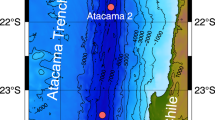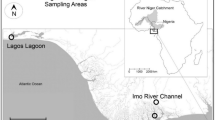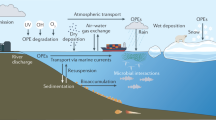Abstract
Atmospheric transport is a major route for entry of chlorinated, aromatic hydrocarbons into aquatic ecosystems. Once in the water, the compounds are readily taken up by the biota and distributed in the food webs. Major fractions of the compounds are deposited in the sediment1, and it had been thought that most persistent contaminants are inactivated in this way as a consequence of their lipophilic properties. However, results from recent laboratory studies2,3 raise the possibility that aquatic sediments may not be the final sink for the substances but may rather act as a source through redistribution of the compounds to water and the atmosphere. Polychlorinated biphenyls (PCBs) may be regarded as ‘tracers’ for these contaminants in the ecosystem, and I studied the transport of PCBs from sediment to water and air in two artificial ponds in the field. The transport from the sediment followed a seasonal cycle; higher concentrations of PCBs in water and air were recorded in the summer and lower in the winter. PCB concentrations in the air over the ponds were positively correlated with PCB levels in the water. My results show that contaminated sediments may act as a source of chlorinated hydrocarbons released into the environment.
This is a preview of subscription content, access via your institution
Access options
Subscribe to this journal
Receive 51 print issues and online access
$199.00 per year
only $3.90 per issue
Buy this article
- Purchase on Springer Link
- Instant access to full article PDF
Prices may be subject to local taxes which are calculated during checkout
Similar content being viewed by others
References
Beeton, A. M. et al. Polychlorinated Biphenyls (National Academy of Sciences, Washington, DC, 1979).
Södergren, A. & Larsson, P. Ambio 11, 41–45 (1982).
Larsson, P. Wat. Res. 17, 1317–1326 (1983).
Larsson, P. Envir. Pollut. 9, 81–84 (1985).
Oliver, B. G. Wat. Pollut. Res. J. Can. 19, 47–58 (1984).
Fischer, J., Petty, R. & Lick, W. Envir. Pollut. 5, 121–132 (1983).
Giam, C. S., Atlas, E., Chan, H. S. & Neff, G. C. Atmos. Envir. 14, 65–69 (1980).
Billings, W. N. & Bidleman, T. F. Envir. Sci. Technol. 14, 443–464 (1980).
Okla, L. & Wesén, C. J. Chromat. 299, 420–423 (1984).
Duinker, J. C. & Hillebrand, M. T. J. Bull. Envir. Contamination Tox. 31, 25–32 (1983).
Doskey, P. & Andrén, A. Envir. Sci. Technol. 15, 705–711 (1981).
Mackay, D., Joy, M. & Paterson, S. Chemosphere 12, 981–997 (1983).
Södergren, A. Nature 236, 395–397 (1972).
Larsson, P. Wat. Res. 18, 1389–1394 (1984).
Author information
Authors and Affiliations
Rights and permissions
About this article
Cite this article
Larsson, P. Contaminated sediments of lakes and oceans act as sources of chlorinated hydrocarbons for release to water and atmosphere. Nature 317, 347–349 (1985). https://doi.org/10.1038/317347a0
Received:
Accepted:
Issue Date:
DOI: https://doi.org/10.1038/317347a0
This article is cited by
-
Impaired benthic macrofauna function 4 years after sediment capping with activated carbon in the Grenland fjords, Norway
Environmental Science and Pollution Research (2021)
-
Seasonal variations of polycyclic aromatic hydrocarbons in coastal sediments of a marine resource hot spot: the case of pars special economic energy zone, Iran
Environmental Geochemistry and Health (2021)
-
Polybrominated Diphenyl Ethers (PBDEs) in Sediments of the Huron–Erie Corridor
Bulletin of Environmental Contamination and Toxicology (2019)
-
Release of anthracene from estuarine sediments by crab bioturbation effects
Environmental Science and Pollution Research (2017)
-
Sequestration of HCHs and DDTs in sediments in Dongting Lake of China with multiwalled carbon nanotubes: implication for in situ sequestration
Environmental Science and Pollution Research (2017)
Comments
By submitting a comment you agree to abide by our Terms and Community Guidelines. If you find something abusive or that does not comply with our terms or guidelines please flag it as inappropriate.



